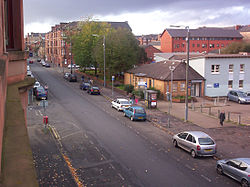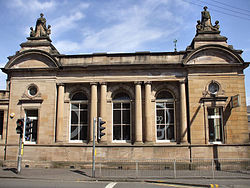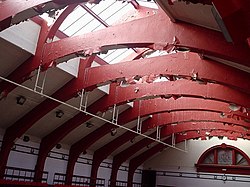Difference between revisions of "Govanhill"
(Created page with '{{Infobox town |name=Govanhill |county=Renfrewshire |picture=Govanhillcalderstreet.jpg |picture caption=Calder Street in Govanhill |population= |os grid ref=NS585628 |latitude=55…') |
|||
| Line 1: | Line 1: | ||
{{Infobox town | {{Infobox town | ||
|name=Govanhill | |name=Govanhill | ||
| − | |county= | + | |county=Lanark |
|picture=Govanhillcalderstreet.jpg | |picture=Govanhillcalderstreet.jpg | ||
|picture caption=Calder Street in Govanhill | |picture caption=Calder Street in Govanhill | ||
| Line 14: | Line 14: | ||
|constituency=Glasgow Central | |constituency=Glasgow Central | ||
}} | }} | ||
| − | '''Govanhill''' in [[ | + | '''Govanhill''' in [[Lanarkshire]] is a district of the City of [[Glasgow]]. It is south of the [[River Clyde]] between the [[Gorbals]] to the north; and [[Mount Florida]] and Queen's Park, both in [[Renfrewshire]], to the south. [[Govan]] is close by to the west. |
| − | + | ||
| − | [[ | + | |
==History== | ==History== | ||
| − | [[File:Govanhill library.jpg | + | [[File:Govanhill library.jpg|thumb|250px|Calder Street frontage of Govanhill Library]] |
The history of the area is linked to the Dixon family. A prominent ironmaster, William Dixon opened blast furnaces to the North of Govanhill which became known as 'Dixons Blazes'. A company village called [[Fireworks Village]] was situated on the site of the later Burgh of Govanhill. The area itself was formed in 1877 and the main avenue that runs the length of it is called Dixon Avenue. Some of the local streets were name after the daughters of William Dixon Jnr; Allison Street, Daisy Street, and Annette Street. Successive waves of immigrants from Ireland, Pakistan and more recently Poland and Slovakia have given the area a rich multicultural identity.<ref>http://www.sundayherald.com/international/shinternational/display.var.1429092.0.glasgow_set_for_multifaith_storytelling.php</ref> | The history of the area is linked to the Dixon family. A prominent ironmaster, William Dixon opened blast furnaces to the North of Govanhill which became known as 'Dixons Blazes'. A company village called [[Fireworks Village]] was situated on the site of the later Burgh of Govanhill. The area itself was formed in 1877 and the main avenue that runs the length of it is called Dixon Avenue. Some of the local streets were name after the daughters of William Dixon Jnr; Allison Street, Daisy Street, and Annette Street. Successive waves of immigrants from Ireland, Pakistan and more recently Poland and Slovakia have given the area a rich multicultural identity.<ref>http://www.sundayherald.com/international/shinternational/display.var.1429092.0.glasgow_set_for_multifaith_storytelling.php</ref> | ||
| Line 28: | Line 26: | ||
==Govanhill Baths== | ==Govanhill Baths== | ||
| − | [[File:Concrete Roofing Struts - geograph.org.uk - 978714.jpg | + | [[File:Concrete Roofing Struts - geograph.org.uk - 978714.jpg|thumb|250px|Interior of Govanhill Baths, showing concrete roof construction]] |
The Govanhill Baths were designed by A B McDonald and opened in 1917 after the architect's death. They contained hot baths in the upper storey and three swimming pools on the ground floor. There was a seating gallery around one of the pools for spectators attending events such as galas. There was also a wash-house or "steamie" at the rear of the building, which was converted to a launderette in 1971. | The Govanhill Baths were designed by A B McDonald and opened in 1917 after the architect's death. They contained hot baths in the upper storey and three swimming pools on the ground floor. There was a seating gallery around one of the pools for spectators attending events such as galas. There was also a wash-house or "steamie" at the rear of the building, which was converted to a launderette in 1971. | ||
Latest revision as of 11:48, 9 May 2018
| Govanhill | |
| Lanarkshire | |
|---|---|
 Calder Street in Govanhill | |
| Location | |
| Grid reference: | NS585628 |
| Location: | 55°50’15"N, 4°15’40"W |
| Data | |
| Post town: | Glasgow |
| Postcode: | G42 |
| Dialling code: | 0141 |
| Local Government | |
| Council: | Glasgow |
| Parliamentary constituency: |
Glasgow Central |
Govanhill in Lanarkshire is a district of the City of Glasgow. It is south of the River Clyde between the Gorbals to the north; and Mount Florida and Queen's Park, both in Renfrewshire, to the south. Govan is close by to the west.
History
The history of the area is linked to the Dixon family. A prominent ironmaster, William Dixon opened blast furnaces to the North of Govanhill which became known as 'Dixons Blazes'. A company village called Fireworks Village was situated on the site of the later Burgh of Govanhill. The area itself was formed in 1877 and the main avenue that runs the length of it is called Dixon Avenue. Some of the local streets were name after the daughters of William Dixon Jnr; Allison Street, Daisy Street, and Annette Street. Successive waves of immigrants from Ireland, Pakistan and more recently Poland and Slovakia have given the area a rich multicultural identity.[1]
Govanhill is home to one of Glasgow's original Carnegie libraries, deftly designed in the Edwardian Baroque style by James Robert Rhind. The library is situated on Langside Road at its junction with Calder Street.[2]
Arts and culture
However, Govanhill is home to a thriving creative arts community, including Dance Factory Dance Studios in Calder Street, Twisty-Headed Man Company on Butterbiggins Road with The Chalet in Dixon Avenue and South Side Studios in Westmoreland Street both home to successful visual artists.
Govanhill Baths
The Govanhill Baths were designed by A B McDonald and opened in 1917 after the architect's death. They contained hot baths in the upper storey and three swimming pools on the ground floor. There was a seating gallery around one of the pools for spectators attending events such as galas. There was also a wash-house or "steamie" at the rear of the building, which was converted to a launderette in 1971.
For many years, the usage of the baths was in sharp decline, with access to the general public being severely limited by "specialist" sessions where only certain members of the paying public were allowed in, and as a general amenity they proved to be non-viable. After the council closed the baths, the campaign to save Govanhill Baths began in December January 2001 which resulted in an occupation of the building by left-wing activists from March 17 until August 7, 2001 when Sheriff's Officers accompanied by police removed the protesters and boarded up the pool. Since then, a growing community has continued campaigning for the redevelopment and reopening of the facilities to residents of Govanhill and surrounding communities. The Govanhill Baths Community Trust organises fundraising events, sends out regular newsletters and runs the highly popular Govanhill Baths Open days in which members of the public are shown round the building for free.
The baths were reported to be a venue for the Big Huge Poetry Splash in 2012, as part of National Poetry Day.[3]
Trivia
Notable current and former residents include psychiatrist and author R. D. Laing, born on Ardbeg Street in 1927.
Brian Francis Connolly (aka McManus), lead singer with popular 1970's glam-rock band Sweet, was born in Govanhill on 5 October 1945.
Johnny Rodger Writer and Lecturer in History and Theory at Glasgow School of Art
Govanhill was featured as the backdrop to the film Small Faces in 1996.[4]
Outside links
- Crosshill and Govanhill Community Council
- Govanhill Baths Community Trust
- Twisty-Headed Man Company
- Southside Festival
References
- ↑ http://www.sundayherald.com/international/shinternational/display.var.1429092.0.glasgow_set_for_multifaith_storytelling.php
- ↑ http://www.glasgowlife.org.uk/libraries/your-local-library/govanhill-library/Pages/home.aspx
- ↑ Provan, Gillian (27 September 2012). "Writers bring poetry to life in the heart of the city's famous landmarks". STV. http://local.stv.tv/glasgow/going-out/events-info/192055-writers-bring-poetry-to-life-in-the-heart-of-the-citys-famous-landmarks/. Retrieved 27 September 2012.
- ↑ http://www.imdb.com/title/tt0114474/

